Improving the environmental impact of civil aircraft by fuel cell technology: concepts and technological progress†
Gwénaëlle
Renouard-Vallet
*a,
Martin
Saballus
a,
Gerrit
Schmithals
a,
Johannes
Schirmer
b,
Josef
Kallo
*b and
K. Andreas
Friedrich
b
aDeutsches Zentrum für Luft- und Raumfahrt (DLR), Institut für Technische Thermodynamik, Hein-Saß-Weg 38, 21129, Hamburg, Germany. E-mail: gwenaelle.renouard-vallet@dlr.de; Fax: +0049 40 743-74727; Tel: +0049 40 743-89390
bDeutsches Zentrum für Luft- und Raumfahrt (DLR), Institut für Technische Thermodynamik, Pfaffenwaldring 38-40, 70569, Stuttgart, Germany. E-mail: andreas.friedrich@dlr.de; josef.kallo@dlr.de; Tel: +0049 711 6862-672
First published on 4th August 2010
Abstract
Nowadays, new technologies and breakthroughs in the fields of energy efficiency, alternative fuels and added-value electronics are leading to improved, more environmentally sustainable and green thinking applications. Due to the forecasted rapid increase of volume of air traffic, future aircraft generations have to face enhanced requirements concerning productivity, environmental compatibility and higher operational availability, thus effecting technical, operational and economical aspects of in-flight and on-ground power generation systems, even if air transport is responsible for only about 2% of all anthropogenic CO2 emissions. The trend in new aircraft development is toward “more electric” architectures which is characterized by a higher proportion of electrical systems substituting hydraulically or pneumatically driven components, and, as a result, increasing the amount of electrical power. Fuel cell systems in this context represent a promising solution regarding the enhancement of the energy efficiency for both cruise and ground operations. For several years the Institute of Technical Thermodynamics of the German Aerospace Center (Deutsches Zentrum für Luft- und Raumfahrt, DLR) in Stuttgart and Hamburg has developed fuel cell systems for aircraft applications. The activities of DLR focus on: identification of fuel cell applications in aircraft in which the properties of fuel cell systems, namely high electric efficiency, low emissions and silent operation, are capitalized for the aircraft application; design and modeling of possible and advantageous system designs; theoretical and experimental investigations regarding specific aircraft relevant operating conditions; qualification of airworthy fuel cell systems; set up and full scale testing of fuel cell systems for application in research aircraft.
In cooperation with Airbus, several fuel cell applications within the aircraft for both ground and cruise operation have been identified. As a consequence, fuel cell systems capable of supporting or even replacing existing systems have been derived. In this context, the provision of inert gas for the jet fuel (kerosene) tank and electrical cabin power supply, including water regeneration, represent the most promising application fields.
This paper will present the state of development and the evolution discussing the following points: modeling of different system architectures and evaluation of promising fuel cell systems; experimental evaluation of fuel cell systems under relevant conditions (low pressure, vibrations, reformate operation, etc.); fuel cell test in DLR's research aircraft ATRA (A320) including the test of an emergency system based on hydrogen and oxygen with 20 kW of electrical power. The fuel cell system was integrated into an A320 aircraft and tested up to a flight altitude of 25 000 feet under several acceleration and inclination conditions; fuel cell tests in Antares-H2—DLR's new flying test bed.
 Gwénaëlle Renouard-Vallet | Dr Gwenaelle Renouard-Vallet is, since June 2004, a researcher at the German Aerospace Center, Institute of Technical Thermodynamics, Department of Electrochemical Energy Conversion/Group Electrochemical Systems in Hamburg, Germany. After a diploma in material engineering in Limoges (France), she fulfilled an international PhD in Canada and France at three research institutes (Sherbrooke University, Limoges University and “Atomic Energy and Alternative Energies Commission”-CEA) on solid oxide fuel cell electrolyte development via plasma technology. In the last few years, her activities have been oriented towards the development of fuel cell systems for aircraft application. Her research interests are fuel cell system behaviour under aircraft environment, research on possible functionalities and integration aspects. |
 Martin Saballus | Dipl.-Ing. (FH) Martin Saballus worked since June 2004 as a graduated engineer at the German Aerospace Center, Institute of Technical Thermodynamics, Department of Electrochemical Energy Conversion/Group Electrochemical Systems in Hamburg, Germany. His major sphere of action has been focused on the development of fuel cell system design for aircraft application. His applied research interests are optimization of system applications from fuel storage to energy supply under different environmental conditions. |
 Gerrit Schmithals | Dr Gerrit Schmithals is, since 2008, a researcher and project leader at the Institute of Technical Thermodynamics of the German Aerospace Center. He finished his diploma in chemical engineering at the Technische Universität Berlin studying analysis techniques for fuel cell membrane manufacturing control. At the Helmholtz-Zentrum Berlin für Materialien und Energie he obtained a PhD working on the characterisation of catalysts for low temperature fuel cells using electrochemical and X-ray absorption techniques. Research activities in recent and current projects concentrate on integration aspects of fuel cell systems in aircraft applications including thermal management, dynamic behaviour and environmental conditions. |
 Johannes Schirmer | Dr.-Ing. Johannes Schirmer started his PhD in 1998 at the Institute for Technical Chemistry I in Erlangen with a thesis in the field of Catalytic Plastic Recycling. In 2002 he started a Postdoctoral research fellow with Basic Research in the field of Direct Methanol Fuel Cells, at the DLR Institute for Technical Thermodynamics in Stuttgart. Since 2005 he is a project manager and research associate at DLR in the field of Fuel cell system development in low power range and fuel cells for aircraft applications. He is/was Project Manager for several projects like PORTAPOWER, Power Pack, ErgoPack; MobilE-Pack; ELBASYS as also Project Coordinator of BZ-BattExt. He contributed as an author to multiple publications and patents on the field of fuel cell applications. |
 Josef Kallo | Dr Josef Kallo started his PhD in 1999 at the “Global Alternative Propulsion Center” of General Motors in Mainz Kastel with a fuel cell related thesis. From 2002 to 2005 he contributed to the development of the General Motors fuel cell driven Zafira H3. In January 2006 Dr Kallo re-established the fuel cell system group at the German Aerospace Center with the main topics fuel cell systems for aircraft applications including the development of an APU replacement unit for large aircrafts and the development of the Antares DLR H2 fuel cell powered 20m wingspan aircraft. The hybrid power plant based on pressurized high temperature fuel cells and gas turbines is a second major topic. Dr Kallo holds the silver f-cell Award and contributed as an author to multiple publications and patents in the field of fuel cell applications. |
 K. Andreas Friedrich | Dr. K. Andreas Friedrich is a Professor of Mechanical Engineering at the University of Stuttgart and the Head of the Fuel Cell Research group at the German Aerospace Center in Stuttgart. His research areas include PEFCs as well as SOFCs. Starting with early fundamental work on electrocatalysts the research becomes increasingly application oriented with recent specialization on aircraft fuel cell systems. The primary goals comprise enhanced power density, long lifetime, reduction of materials and manufacturing costs, identification and prevention of degradation mechanisms in stacks, advanced and optimised integration of fuel cells into energy supply systems. Dr. Friedrich has authored and co-authored more than 80 papers in the described research fields. |
Broader context“Green flying”—fuel cell systems as part of the electrical supply in civil aircraft are making this expression a reality. Indeed, fuel cell systems have high electrical efficiency and only produce water and oxygen depleted air as gas emissions. What is also very innovative is that these “waste products” can be used to generated water on board and be used as inert gas in the jet fuel tank as a fire retardation and suppression measure or even complete explosion prevention. For several years the Institute of Technical Thermodynamics of the German Aerospace Center, in cooperation with Airbus, has developed fuel cell systems which fulfil these functionalities for both aircraft ground and cruise operation. This paper presents all the modelling and experimental activities which have been performed in the last few years to make a dream come true—flying as green and silent as a sparrow (Antares-H2) or a condor/swan (ATRA A320). |
Introduction
According to the IPCC (2000) reports1 and the newest environmental studies,2 air transport is responsible for about 2% of the worldwide CO2 emissions and will probably rise up to 3.5% due to the drastic increase of air traffic over the last decades and the expected further growth (see Fig. 1). Because of the rising public awareness about the environmental impact of air traffic, international institutions like the European Community have increased the pressure on aircraft manufacturers to improve the efficiency of their aircrafts and lower their environmental impact. Indeed, the ACARE (Advisory Council for Aeronautics Research) has issued their Vision 2020 goals for aeronautic research in which a reduction of CO2 emissions by 50%, and of NOx emissions by 80% is envisioned.3 | ||
| Fig. 1 Scenario of the evolution of CO2 emissions in aviation, adapted from ref. 2. | ||
The restriction of the noise and of the emissions (CO, NOx and HC) in airports has already led to some stringent limitations on travel schedules and flight intensity in industrialized countries. Moreover, airlines have to expect aircraft movement quotas, higher taxes and airport tariffs dependent on the ground emissions of their fleet. Therefore future aircraft generations have to meet not only higher environmental standards but also higher economical and productivity requirements. These trends also have implications for technology and economics of the on-board power generation. For several years a clear tendency to replace hydraulic and pneumatic aircraft systems by electrical systems can be observed (often denominated “more electric aircraft”).
Traditionally the electrical power on board is provided with high efficiency by the aircraft's main propulsion engines, with low efficiency by a gas turbine auxiliary power unit (APU) or with better efficiency by a ground power unit (GPU). In flight, the efficiency of electric power generated by the main engines and their generators can reach 40%, however, on the ground with the engines shut off, the average fuel efficiency of the turbine-powered APU is typically less than 20% and when idling even in the area of 10%. In addition, the undesirable noise and gaseous emissions of the APU have a negative effect and its use is forbidden in an increasing number of airports.
Due to their high electrical efficiency and environmentally friendly behavior, fuel cell systems are attractive solutions to improve the environmental impact of aircraft systems. Therefore publications and research activities in this area have grown considerably the last few years, driven by the two large aircraft manufacturers Boeing and Airbus. Challenges nevertheless remain to successfully apply the technology to commercial flying systems.
Two fuel cell technologies are the center of the research activities on different levels: the SOFCs (solid oxide fuel cells) and the PEFCs (proton exchange membrane fuel cells).
The high temperature SOFCs and the associated fuel processing are theoretically and conceptually well-suited because of their similarity in operating temperature and the possible hybrid configurations with gas turbine to increase efficiency. Several studies which were initiated by Boeing to investigate hybrid configurations of SOFC and micro gas turbines in aircraft have been published indicating—from a conceptual viewpoint—a large benefit for high-temperature systems.4–6 However, both technologies are not yet mature enough for transportation applications, as extremely large improvements in power density of SOFCs and compact and reliable fuel processors are needed for achieving the aircraft requirements.
The PEFCs are not far from the industrialization stage in the automotive industry and they are therefore a good candidate for the near future integration in aeronautic applications. Nevertheless, due to typical aircraft requirements, a lot of challenges still have to be met: improving the specific power of the stack, reducing the weight of the remaining components, and investigating flight-operation conditions. Regarding this concern, on the one hand, Boeing has recently demonstrated a small manned two-seater prototype composite motor glider airplane powered by proton exchange membrane (PEFC) fuel cell stacks and Li-ion batteries in a hybrid configuration.7 The fuel for the PEFC is compressed hydrogen gas as fuel and pressurized air as oxidant. The fuel cell system was used for in-flight cruising. For take-off, both the batteries and fuel cell are needed. On the other hand, Airbus is developing PEFC systems for specific aircraft APU applications.8
The goal of Airbus is to incorporate several functions and products of the fuel cell system into the aircraft architecture in order to demonstrate not only ecological but also economical benefits which would justify the additional costs of fuel cell technology. Starting from the application with the easiest technical requirements the strategy consists of integrating evermore intricate functions into the system. It is important that the next generation development should always include the functions of the preceding development generation. The first step in this development roadmap has been demonstrated by several successful flight tests of a 20 kW emergency power fuel cell system as a result of a collaboration between DLR, Airbus and Michelin. A fuel cell system operated with H2/O2 from Michelin operated the control surfaces of the aircraft during flight. The fuel cell system showed a very robust behavior even at significant accelerations.9
This contribution describes the state and progress of the aircraft related development of DLR in cooperation with Airbus and the next planned steps for fuel cell aircraft demonstration. The following tasks have been fundamental for the definition of a multifunctional fuel cell application in aircrafts:
• Based on system modeling, the various applications of fuel cell systems have been evaluated and fuel cell designs have been derived.
• The fields of application for the fuel cells in civil aircrafts have been identified and the potential advantages in this application have been elaborated.
• Various fuel cell systems and functional sub-systems have been investigated in the laboratory environment taking into account aviation relevant operating conditions (like ambient and operating pressure). Important operation conditions included low pressure operation, climatic changes and inclination and orientation measurements. The quality of the product water and the cathode exhaust were analyzed.
• Modified and adapted fuel cell systems were qualified for aircraft application.
• The first systems were tested in the research aircraft A320 ATRA.
• New testing bed and platforms like the motor glider Antares DLR-H2 were conceived and successfully tested.
The multifunctional concept for fuel cell systems in aviation: a step by step approach
Power generation
One of the main deficits of the current power supply systems in aircraft is that they are often operating in an inefficient way (sometimes high energy consuming). As an example, the auxiliary power unit (APU) has a low efficiency of only 20% and even lower10 at part load conditions; moreover, according to a study by Zuerich airport the APU is responsible for 18% of nitric oxide emissions and also for significant carbon monoxide emissions. In addition, the noise emissions of the APU are of special concern as they are responsible for health problems, mainly of ground personnel. The APU which is located in the tailcone of passenger aircrafts is a gas turbine which delivers electrical energy, compressed air and hydraulic pressure for a self-sufficient operation of aircraft systems on the ground without main engines. The most important function of the APU is the main engine start. Other systems that can be operated by the APU include the avionic systems, the environmental control system (air conditioning) and the de-icing devices. The APU itself is started from batteries or—if the main engines are operating—by pneumatic energy. Normally the APU is shut down after the start of the main engines. The electrical ground supply can be supplied advantageously by a hydrogen based fuel cell system since it has a better electrical efficiency and does not produce greenhouse gas emissions and is relatively quiet.Another system with large potential for improvement is the required emergency power system—the Ram Air Turbine (RAT)—which generates electricity from the air stream (essentially the RAT is a propeller). In the case of failure of all engines (which is a very rare event) the hydraulic system and the electric systems of the aircraft are lost. In this case the aircraft is not controllable anymore as the control surfaces, which are normally hydraulically or electrically controlled, can not be steered. In such a case the RAT is automatically or manually swung out at the underside of the aircraft body or the wings and provides the necessary electrical power for the controls through a hydraulic pump or an electric generator depending on the aircraft type. In the meantime, electrical power is also provided for the fly-by-wire systems and the cabin emergency light. The efficiency of the RAT generator depends on the altitude and the aircraft speed. The pilot has about 30 min to find the next airport in a gliding flight if the main engines can not be restarted. After use the RAT can not be retracted anymore even if the main engines are again operational. This emergency function can also be realized advantageously by a fuel cell system since the RAT presently causes high maintenance costs and leads to worse aerodynamic properties of the aircraft when active.
During cruise the electrical energy is provided by the generators of the main engines. The efficiency of this energy supply is quite high, around 30–40%, however, this efficiency can be exceeded by fuel cell systems which can reach 50% of electrical efficiency.
The primary goal of fuel cell systems in aircrafts is to avoid inefficient operation phases of aircrafts. In this respect, the elimination of the APU and the RAT is envisioned. The first application of fuel cell systems in a commercial aircraft has so far been the demonstration of emergency power. The first fuel cell emergency system with hydrogen/oxygen operation has been demonstrated in-flight with the DLR research aircraft A320.9
However, the APU replacement or RAT replacement alone would not justify the relatively high development effort for fuel cell systems since the gravimetric power density of the gas turbine is significantly superior to even the most advanced fuel cell system. Therefore, a multifunctional approach of fuel cell systems is foreseen for civil aircraft applications. Indeed, fuel cell systems can supply power but can also deliver further functions and products like water and low-oxygen containing exhaust air for inerting of the jet fuel tank. Another function may be the use of the heat of the fuel cells for de-icing.
Having a multifunctional architecture of the fuel cell system (see Fig. 2) within the aircraft can compensate for the mass penalty of fuel cells compared to the gas turbine on the aircraft level.
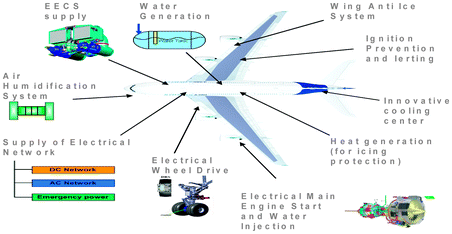 | ||
| Fig. 2 Multifunctional fuel cell system; the possible functions are power supply, emission free ground operation, electrical main engine start, electrical environmental control system (EECS), water generation (portable water and water for toilets), heat generation (ice prevention, hot water generation), explosion and fire prevention and suppression (inerting of tanks, cargo and e-bay compartment), cockpit and/or cabin air humidification. | ||
Water generation and inert gas generation
Fuel cell system can deliver ca. 0.5–0.6 L of water per kW h electrical power (see Fig. 3); which means that for 100 kW fuel cell power (appropriate for a large aircraft) about 50 L of water are generated per hour. This can be used for toilets and air conditioning, thereby reducing the amount of water to be loaded on-board the aircraft. Therefore water generation by the fuel cell will help reduce the water mass in the tank of the aircraft. The conditioning and the water quality were and are still the subject of research and development for improvement and optimization (National German Projects APAWAGS, ELBASYS and BRINKS). Another advantageous aspect in this regard is the reduced maintenance for fuel cell product water compared to tap water.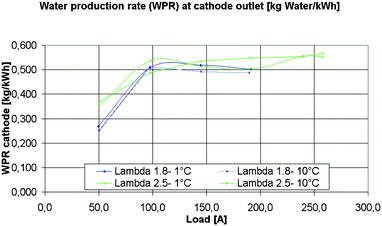 | ||
| Fig. 3 Water production rate for a commercial PEFC from © Hydrogenics type HyPM XR12 for different operating conditions and different temperatures of condensation. | ||
The use of the fuel cell exhaust, which is oxygen depleted air, is very innovative. Tests of various fuel cell systems have shown only 10% of oxygen content in the exhaust (see Fig. 4) by reducing air stoichiometry.
 | ||
| Fig. 4 Variation of oxygen content in a commercial PEFC from © Hydrogenics type HyPM XR12 fuel cell exhaust depending on operating parameters. | ||
These low oxygen contents in the tank are effective as fire retardation and suppression measures or even complete explosion prevention. New rules of American and European aeronautical authorities dictate inerting systems for the jet fuel tank in new aircraft models and as retrofit for in-service ones (an inflammability of jet fuel is not possible for oxygen contents below 12% by volume). If the fuel cell can satisfy this function, the presently used inerting systems based on nitrogen tanks can be eliminated. Fig. 2 displays schematically the functions that a multifunctional fuel cell system may be able to fulfil.
System evaluation taking into account the inerting function and the water generation show that the weight penalty of fuel cell systems compared to gas turbines can be compensated leading to weight benefits of over a ton which increase with mission duration. For each airplane type a maximum benefit is found for specific powers (e.g. ca. 300 kW for A380). In addition, due to saving of jet fuel, snowball effects with further weight benefits can be considered. However, the airlines can choose to consider longer missions instead of less fuel load.
Development strategy
The development strategy aims to demonstrate first the emergency system which is also the easiest function for a fuel cell system. In the next step a multifunctional system also including the emergency function should be demonstrated. The time dependent development steps are schematically shown in Fig. 5. It is important in this respect that each new generation should include the function of the preceding generation. In this regard the fuel cell system becomes more complex with each generation since more functions are integrated. However, the benefits for the aircraft also improve. The abbreviations used in Fig. 5 are FCEPS (Fuel Cell Emergency Power System), FCWIP (Fuel Cell System for Water, Inert-Gas and Power), and MFFCS (Multi-Functional Fuel Cell System).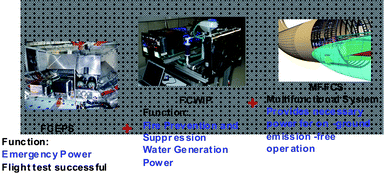 | ||
| Fig. 5 Development strategy of Airbus with different fuel cell system development generations. | ||
Evaluation of system architectures
Low temperature fuel cell systems, in particular PEFC-based architectures, are currently the only fuel cell type that satisfies the maturity and power density requirements for aircrafts. They can vary significantly in design and functionality. The differences in the individual set-ups arise from the specific application purposes as well as from optimization efforts intended to improve the system performance specifically for various aircraft functions. Consequently not all systems would be suited for aircraft application to the same extent. Based on this background a design study was carried out to find auspicious architectures and reduce the number of eligible system setups.10,11The main components of the fuel cell system are the gas and air supply, the fuel cell stack, the cooling system and the electrical power management (DC/DC, DC/AC converter). The humidification system for the fuel cell membrane is integrated into the gas and air supply system as the media are humidified. To evaluate the possible architecture, it was chosen to take into account the potential supply scenarios of the working gases. Fig. 6 displays the described approach by showing the considered fuel supply routes, resulting in 12 basic system setups. The adjacent detailed arrangement of the individual architectures was finalized assuming the least number of additional balance-of-plant components necessary to enable stable operation. Due to safety considerations, the deployment of an afterburner in combination with the application of a jet fuel reformer was additionally proposed. In this context, an off-stream turbine for cruise conditions appears favorable with respect to system efficiency. Reformer-based system architectures including an expander were therefore additionally investigated.
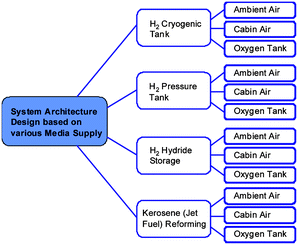 | ||
| Fig. 6 Supply combinations for system architecture study.10,11 | ||
For an objective assessment of the 12 established fuel cell systems, criteria for a quantitative design were derived with regard to the application in an aircraft environment. In Table 1 the chosen criteria are displayed. In addition a consistent system operation point was selected for the evaluation of the single architectures, also listed in Table 1. The distinction between cruise and ground scenarios results in this context from strongly different surrounding and operation conditions. For ground operation it is additionally assumed that ambient and cabin air comprise identical properties. Finally, the assessment neglects the energy necessary to provide compressed hydrogen and oxygen from respective tanks.
| Operation Conditions | ||
|---|---|---|
| Cruise | Ground | |
| H2 stoichiometry | 1.1 (1.3)a | 1.1 (1.3)a |
| O2 stoichiometry | 2 (1.3)a | 2 (1.3)b |
| Fuel cell current density [A cm−2] | 0.75 | 0.75 |
| Fuel cell stack inlet temperature [K] | 353 | 353 |
| Fuel cell stack inlet pressure [bar] | 1 | 1.2 |
| Electric power [kW] | 50 | 50 |
| Flight route [miles] | 810/1900/>1900 | — |
| Operating time [min] | 96/228/720 | 60 |
The evaluation of the systems is first based on stationary modeling of the relevant properties. In Fig. 7 typical results for system mass and system efficiencies are given. The system mass advantage resulting from the greater gravimetric energy density of kerosene in comparison to pure hydrogen leads to an improved suitability of reformer based systems for long range applications. Since the aircraft efficiency (distance traveled vs. kerosene usage) has not been considered with respect to the overall weight the values displayed for reformer-based system are expected to be even higher. However, since the mass is just one evaluation criteria for the complex requirements, a superior assessment of reformer-based systems is not found. To illustrate the opposing characters of different evaluation criteria, system mass and efficiency as a result of the steady state evaluation campaign are shown in Fig. 7(b) for cruise conditions.
 | ||
| Fig. 7 (a) Evaluation of system mass for varying hydrogen supply concepts and the usage of cabin air; (b) relative system efficiencies for considered architectures at cruise conditions—for air supplied reformer-based systems an off-stream turbine is included.11,12 | ||
In addition to a cumulative evaluation, a weighted assessment of the considered 12 architectures was carried out with regard to different aircraft applications. In Table 2, a selection of specific aircraft applications, which can be realized with fuel cell systems is displayed (relevant criteria are in brackets).
| System Setup |
|---|
| Application oriented evaluation |
| Engine start up (system mass, dynamics) |
| Front wheel drive (system mass, system efficiency) |
| Ram air turbine (simplicity, safety, system mass, dynamics) |
| Cabin electrical power (dynamics, system mass and efficiency) |
| Water generation and tank inerting (applicability, system mass) |
The application oriented results11 support the positive evaluation of hydrogen pressure tank based system architectures. A good performance can also be expected for the usage of H2 cryogenic tanks.
This trend is confirmed by another study performed in DLR internal project Cosicab+12 evaluating the different hydrogen storage types for aircraft application based on A320 basic mission and turn-over. In Fig. 8 the weights of the different storages are evaluated for a typical day of operation of an A320.
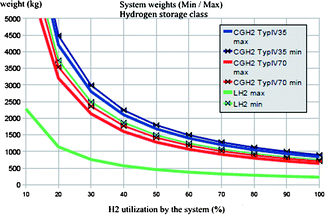 | ||
| Fig. 8 Weights of the hydrogen storage system. | ||
The multifunctional fuel cell system: a path towards aircraft integration
In a national project ELBASYS, the DLR was responsible for the integration of a multifunctional fuel cell system into aircraft architectures. Three main working tasks are defined in this project.The first task consists of the integration of an already qualified H2/O2 fuel cell system for emergency power into the research aircraft A320 (D-ATRA). The fuel cell system was delivered by Airbus (manufacturer Michelin) to DLR. This system was integrated into the cargo area of the A320 at the Airbus location in Hamburg/Germany and tested in several flights with standardized missions. The data acquisition of the fuel cell system performance was measured under realistic vibration loads, heat rejection and safety aspects. The flight specific data measured includes temperature, pressure, vibrations, orientation angles, etc. The fuel cell system demonstrated a robust behavior in all tests (see Fig. 9).
 | ||
| Fig. 9 (a) DLR research aircraft A320 (D-ATRA) at the Berlin International Air Show (ILA) 2008. (b) Michelin fuel cell system in the cargo area of the research aircraft. (c) Typical data of a flight test in July 2007. Power of the fuel cell at the start of the emergency system during a curve in flight. | ||
The second fuel cell system being set-up at DLR will demonstrate multiple functions on-board. Besides emergency power, the system should deliver inert gas for the jet fuel tank and water.
This task therefore consists of developing a H2/air fuel cell system. The fuel cell system is based on commercial systems‡ which are modified and adapted to fulfil the rules and regulation of aircrafts. The task consists of developing new designs, modifying components and developing an aviation-qualified control system. For that purpose a flexible aircraft qualified platform is being developed in which different components can be changed rapidly without the need to start all qualification routines again. With this airworthy test platform the development of aircraft fuel cells can be drastically accelerated. The schematic of this platform is presented in Fig. 10.
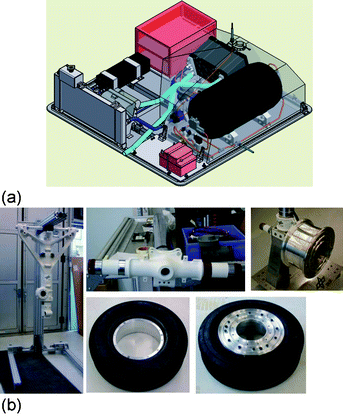 | ||
| Fig. 10 (a) Design of the airworthy (aircraft qualified) testing platform for fuel cell systems. (b) Components for the electrical nose wheel drive for emission-free ground operation. | ||
The third largest task consists in demonstrating an emission-free ground operation. In particular, an electrical drive for the nose wheel is being developed to show a fuel cell powered ground taxiing of the A320. The ground taxiing is presently performed by using the thrust of the main engines at low load thereby producing a lot of noise and emissions at airports. The work consists again in qualifying all components for aircraft application. A very interesting aspect is the coupling of four 12.5 kW systems in a completely modular way to realize a redundant system design.
Aircraft relevant investigations
Tests in laboratory environment
In the framework of internal projects DLR has tested cells and systems under aircraft relevant conditions in the laboratory environment. A specific test is the low pressure operation test down to 200 mbar which corresponds to a flight height of ca. 12![[thin space (1/6-em)]](https://www.rsc.org/images/entities/char_2009.gif) 000 m (ca. 39
000 m (ca. 39![[thin space (1/6-em)]](https://www.rsc.org/images/entities/char_2009.gif) 000 ft) (Fig. 11). Even if the final fuel cell system will probably be operated with cabin air, such characterizations are of paramount importance for system evaluations. The testing results which also include different orientations, vibrational load behavior, electromagnetic compatibility and water analysis, allow designing a layout of the system regarding its performance during cruise conditions. Furthermore, the detailed system design leads to estimations of mass and volume of components and subsystems as well as a detailed specification for all components. Operation strategies as well as the evaluation of detailed system architectures are only possible if the aircraft relevant performance data of fuel cell systems are known. The testing work has provided criteria and results on the following aspects:
000 ft) (Fig. 11). Even if the final fuel cell system will probably be operated with cabin air, such characterizations are of paramount importance for system evaluations. The testing results which also include different orientations, vibrational load behavior, electromagnetic compatibility and water analysis, allow designing a layout of the system regarding its performance during cruise conditions. Furthermore, the detailed system design leads to estimations of mass and volume of components and subsystems as well as a detailed specification for all components. Operation strategies as well as the evaluation of detailed system architectures are only possible if the aircraft relevant performance data of fuel cell systems are known. The testing work has provided criteria and results on the following aspects:
• Special requirements of fuel cell systems in aircrafts
• Identification of suitable system designs
• Fuel supply possibilities
• Efficient utilization of PEFC in aircrafts
• Increase and optimization of efficiency, reduction of noise and emissions
• Possibilities for efficient water management and fuel cell cooling.
 | ||
| Fig. 11 (a) Photo of a test set-up for analyzing low-pressure behavior of PEFC systems. (b) Example of the pressure dependence of a 300 W PEFC system in the pressure range from 950 to 200 mbar. | ||
A further priority topic was the technical screening of different commercial systems‡ in different configurations. DLR has focused on the adaptation and modification of different systems for aircraft qualification. In the test of different orientations (inclinations) of the systems, adverse angles were identified. An example is given in Fig. 12 where the system shows a decrease of cell voltage at an angle of 30° under load (adverse operating condition) mainly at reduced air stoichiometries which are of interest for the inerting function. This performance instability is due to the water management of the system associated with water accumulation at the cathode. With a slight change in the system configuration, however, this problem can be effectively avoided.
 | ||
| Fig. 12 (a) Inclination test station. (b) Testing results of a 12.5 kW system under different orientations. At low air stoichiometries of 1.6 the voltage decreases at 30° angles. | ||
Another test bed has been developed to experiment with the different possibilities of conditioning the fuel cell cathode exhaust gas in order to optimize the produced water and condition the inert gas before its distribution in the kerosene tank. In this test bed (Fig. 13(a)), it is possible to measure the cathode exhaust gas characteristics as mass flow, relative humidity, oxygen concentration (Fig. 13(b)), pressure and temperature at different points of the system in order to assess the different subsystem behaviors. A vacuum pump and a small tank allow simulation of a pressure change in the system representative of the one expected in flight.
 | ||
| Fig. 13 (a) Test bed measurement station. (b) Typical test results of O2 concentration measurement. | ||
Flight testing and development of new testing beds
An important milestone in the development efforts has been the first test of a fuel cell in a civil aircraft environment through a collaboration of Airbus, DLR and Michelin to power the aircraft's back-up hydraulic and electric power systems. The test conducted in DLR's D-ATRA (“Advanced Testing and Research Aircraft”) in 2007 and 2008 is part of Airbus' overall plans for an eco-efficient aviation industry (see description above). During the test, the hydrogen and oxygen based fuel cell system generated up to 20 kW of electrical power. The fuel cell system powered the aircraft's electrical motor pump and the back-up hydraulic circuit and also operated the aircraft's ailerons. The system's robustness was confirmed at high gravity loads (“g” loads) during turns and zero gravity aircraft maneuvers. During the flight test, the fuel cells produced around 10 L of pure water.Fig. 9 shows the DLR-ATRA at the Berlin International Air Show (ILA) 2008 (a), the tested Michelin fuel cell system in the cargo area of the aircraft (b) and the curves of the behaviour of the fuel cell system during the flight test (c).
A new testing bed has been developed by DLR in cooperation with Lange Aviation (Fig. 14). The Antares DLR-H2 is a high-tech motor glider aircraft based on the Antares 20E which has been built commercially. The Antares was modified by attaching two pods below the wings to carry the fuel cell system and the hydrogen tanks. The fuel cell is slung under the left wing and the hydrogen tank under the right wing—with a capacity of either 2 or 4.9 kilograms. For that reason the wings had to be strengthened and extensive aeroelastic and aerodynamic modeling had to be performed to ascertain the flight stability.
 | ||
| Fig. 14 (a) Testing bed DLR-H2 for fuel cell propulsion with hydrogen. (b) Specifications of the Antares motor glider from Lange Aviation. (c) View of the hydrogen tank in the pod. (d) View of the altitude record. | ||
The advantage of the new test bed consists of the combination of different qualifying test routines. Acceleration loads, vibration loads and climatic environments can be tested in a single run. Furthermore, the motor glider has reduced qualification demands and reduced regulations in comparison with a civil aircraft as the high gliding ratio allows a safe landing even in the event of a fuel cell failure. The DLR-H2 in this regard is an inexpensive testing environment in which the systems for civil aircraft can be tested in a flexible way. The fuel cell provides the energy for the electric drive train developed by Lange Aviation which consists of high-performance electronics, electric motors and propellers.
The Antares DLR-H2 first officially took off on 7th July, 2009 at Hamburg airport. It is the world's first piloted aircraft capable of taking off using only power from fuel cells.
The fuel cell system§ used to power the Antares delivers up to 25 kilowatts of electrical power. When flying in a straight line, the aircraft only requires about ten kilowatts of power. In this situation, the fuel cell is operating at an efficiency level of approximately 52 percent. The total efficiency of the drive system from tank to power train, including the propeller, is in the region of 44 percent, making it about twice as efficient as conventional propulsion technologies based on combustion processes. Systems powered by kerosene or diesel only contribute about 18 to 25 percent of their energy to propulsion.13
On top of that, on 21st November, 2009, Antares successfully completed an altitude record reaching (see Fig. 14 (d)) about 8368 ft (ca. 2550 m) in height, corresponding to an operating pressure for the fuel cell of about 725 millibars.14 This corresponds roughly to a minimum air pressure in the cabin of an Airbus A320 flight during a normal flight and is about 290 millibars below the normal atmospheric pressure (Fig. 14 (d)). The behaviors of the fuel cell at lower pressure (Fig. 11) obtained, until now, in the laboratory environment were thus confirmed in real flight.
Outlook and summary
A strategic cooperation between Airbus and DLR in the context of ecologically friendly aircraft systems has resulted in the first results for the development of fuel cell systems for future aircraft. This goal is supplemented by further development of complex electrical architectures, which will lead to an overall improvement of energy efficiency, as well as by the development of a control system for reliable multifunctional operation. In future developments, the conventional air and hydraulic systems will be mostly replaced by electrical components. New avionic systems may accelerate this tendency. The multifunctional approach to fuel cell systems may lead to further modifications in various aircraft systems for efficient energy use on board. The goal of Airbus and DLR is to conceive innovative electrical architectures in which the multifunctional fuel cell system is a key component to ascertain a technology leadership for efficient future aircrafts. This goal will be supported by national projects like EFFESYS and Greenliner.DLR has worked on system modeling and simulation to identify beneficial system designs and multiple functions. The first fuel cell system for emergency power has been demonstrated together with Airbus and Michelin on an A320. An airworthy test platform for flexible investigations of the multiple functions and applications is being developed. This platform will be used for flight test and rapid change of components. The platform is planned to be tested in-flight in the A320. Furthermore, emission-free ground operation is being developed and demonstrated. Arising from the need to perform inexpensive and flexible fuel cell system tests in the realistic environment, the testing bed DLR-H2 will be used intensively within the next few years also within the framework of national projects.
Acknowledgements
The development presented is a team effort. The authors are grateful to the Fuel Cell team of Airbus for the good collaboration and teamwork the last few years and the team of Michelin for their contributions. In addition, the authors acknowledge the contributions of Peter Schumann (system modeling), Michael Schier (electric drives), Christoph Fischer, Gerhard Schuller, Oliver Thalau (flight qualification and platform), Till Kaz, Forian Gores (Antares DLR-H2), Winfried Göbel (low pressure studies), and Jonathan Wicker (inclination tests). Special thanks are due to Lufthansa Technik AG that donated the nose wheel of an A320.Notes and references
- J. E. Penner, D. H. Lister, D. J. Griggs, D. J. Dokken, and M. McFarland, Aviation and the Global Atmosphere, IPCC special Report, The Hague, 2000 Search PubMed.
- David S. Lee, David W. Fahey, Piers M. Forster, Peter J. Newton, Ron C. N. Wit, Ling L. Lim, Bethan Owena and Robert Sausen, Aviation and global climate change in the 21st century/Atmospheric Environment, 2009, 43, 3520–3537 Search PubMed.
- ACARE report, European Aeronautics: A Vision for 2020, Office for official publications of the European Communities, L-2985Luxembourg, 2001 Search PubMed.
- R. Tornabene, X.-Y. Wang, C.-J. Steffen Jr, J. E. Freeh, NASA/TM—2005-213819, report of National Aeronautics and Space Administration, Development of Parametric Mass and Volume Models for an Aerospace SOFC/Gas Turbine Hybrid System, Cleveland, OH, USA, 2005 Search PubMed.
- J. E. Freeh, C. J. Steffen Jr, L. M. Larosiliere, Off-Design Performance Analysis of a Solid-Oxide Fuel Cell/Gas Turbine Hybrid for Auxiliary Aerospace Power, Proceedings of FUELCELL 2005, 3rd Intern. Conference on Fuel Cell Science, Engineering and Technology, May 23–25, 2005, Ypsilanti, Michigan, USA Search PubMed.
- S. Eelman, D. L. Daggett, M. Zimmermann, G. Seidel, High Temperature Fuel Cells as Substitution of the Conventional APU in Commercial Aircraft, DGLR-JT2003–183, Deutscher Luft- und Raumfahrtkongress, 2003 Search PubMed.
- N. Lapena-Rey, J. Mosquera, E. Bataller, F. Orti, C. Dudfield and A. Orsillo, J. Power Sources, 2008, 181, 353 CrossRef CAS.
- V. Rouss, P. Lesage, S. Begot, D. Candusso, W. Charon, F. Harel, X. Francois, V. Selinger, C. Schilo and S. Yde-Andersen, Int. J. Hydrogen Energy, 2008, 33, 6755 CrossRef CAS.
- Airbus International Press Release, Emission free power for civil aircraft: Airbus successfully demonstrates fuel cells in flight, 19 February 2008, http://www.airbus.com/en/presscentre/pressreleases/pressreleases_items/.
- P. Schumann, C. Graf and K. A. Friedrich, ECS Transactions, 2008, 12(1), 651 Search PubMed.
- P. Schumann, C. Graf, J. Kallo, K. A. Friedrich, Proceedings of H2Expo International Conference and Trade Fair on Hydrogen and Fuel Cell Technologies 2008, Hamburg, 2008 Search PubMed.
- M. Saballus, in German, Studie zur Versorgungsstrategie von Wasserstoff im Flugbetrieb, Report DLR internal Project, CoSiCab+, AP 6100: Wasserstoffversorgung und Speicherung, Hamburg, 2009 Search PubMed.
- DLR National Press Release: DLR motor glider Antares takes off in Hamburg – powered by a fuel cell, 7 July 2009, http://www.dlr.de/en/desktopdefault.aspx/tabid-344/1345_read-18278/.
- DLR National Press Release, Antares DLR-H2 stellt Höhenrekord auf, 21 November 2009, http://www.dlr.de/desktopdefault.aspx/tabid-344/1345_read-21170/.
- X. Zhu, H. Zhang, Y. Zhang, Y. Liang, X. Wang and B. Yi, J. Phys. Chem. B, 2006, 110, 14240–14248 CrossRef CAS.
- J. Zhang, Z. Xie, J. Zhang, Y. Tang, C. Song, T. Navessin, Z. Shi, D. Song, H. Wang, D. P. Wilkinson, Z. S. Liu and S. Holdcroft, J. Power Sources, 2006, 160, 872–891 CrossRef CAS.
Footnotes |
| † This article results from the Hyceltec 2009 meeting. |
| ‡ The fuel cell systems used for the demonstration of multiple functions on-board are low temperature PEFC with self-humidifying membrane. More details on these self-humidifying processes can be found in the literature.15 |
| § The fuel cell systems used in the new testing bed Antares are high temperature PEFC with PBI membrane. More information about this technology can be found in ref. 16. |
| This journal is © The Royal Society of Chemistry 2010 |
